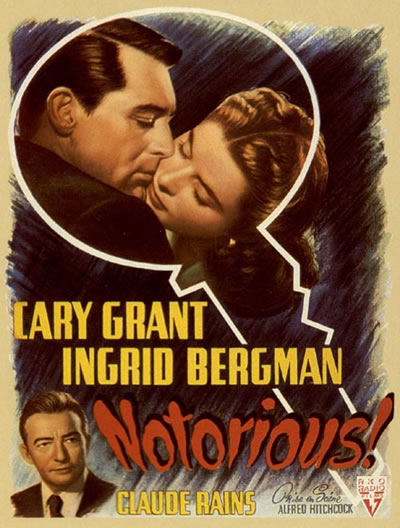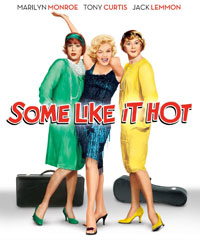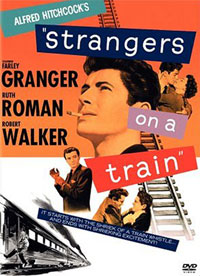Notorious
 The massive career of Alfred Hitchcock can be broken down into three sections. There’s his early British career (that includes both silent films and talkies) that ends with Jamaica Inn in 1939. Then there’s the first half of his American period; he crossed the ocean and found instant success with Rebecca and continued to hone his craft and try out different genres during the 1940s and early ‘50s. And then finally there’s his most celebrated period beginning around ’54 with Rear Window and Dial M for Murder, where the name Hitchcock became a brand and most of his films were events in themselves. Of that middle period, besides Rebecca there are a number of celebrated and still admired flicks including Spellbound, Shadow of a Doubt, and Strangers on a Train. But one film that really stands out, less flashy than the others but more emotionally devastating, is Notorious. On paper it’s an espionage thriller, but it’s actually one of the great heartbreaking love stories of the era.
The massive career of Alfred Hitchcock can be broken down into three sections. There’s his early British career (that includes both silent films and talkies) that ends with Jamaica Inn in 1939. Then there’s the first half of his American period; he crossed the ocean and found instant success with Rebecca and continued to hone his craft and try out different genres during the 1940s and early ‘50s. And then finally there’s his most celebrated period beginning around ’54 with Rear Window and Dial M for Murder, where the name Hitchcock became a brand and most of his films were events in themselves. Of that middle period, besides Rebecca there are a number of celebrated and still admired flicks including Spellbound, Shadow of a Doubt, and Strangers on a Train. But one film that really stands out, less flashy than the others but more emotionally devastating, is Notorious. On paper it’s an espionage thriller, but it’s actually one of the great heartbreaking love stories of the era.
Just after WWII, Alicia Huberman (Ingrid Bergman), the party girl daughter of a convicted Nazi spy, is recruited by an American Intelligence agent, T. R. Devlin (Cary Grant), to prove her love to the red, white, & blue by infiltrating a group of Nazis who are hanging out in Brazil, planning a little postwar revenge against the USA. Things get complicated when, while waiting for the job to start, the two beautiful people fall in love. When the details arrive, it’s ugly; she has to go seduce an older ex-boyfriend, Alex Sebastian (Claude Rains), and find out what he and his cronies have in mind. She desperately wants Devlin to stand by and trust her; but though he does genuinely love her, he’s too cool to put down his guard and too professional to stop his bosses from deploying her. Still hoping to end up with Devlin, the dutiful Alicia takes the job and seduces Sebastian so well that he asks her to marry him, even while knowing she may be setting him up. It’s a love triangle, but in a twisted kind of knot that only Hitchcock could devise.
Dr. Strangelove Or: How I Learned To Stop Worrying & Learned To Love The Bomb

In the heart of the Cold War, after the Cuban missal crisis, fresh from the assassination of President Kennedy, the world seemed to be on the brink of nuclear destruction. It was a tense era, as reflected by a number of the paranoid films that were produced - Fail-Safe, Seven Days In May, On The Beach, to name a few. Knowing the world it was released into makes the attitudes of the "black comedy" Dr. Strangelove Or: How I Learned To Stop Worrying and Learned To Love The Bomb, particularly black. While many Americans had fall-out shelters in their backyards, Stanley Kubrick's film was laughing at the ridiculousness of world annihilation, while wondering who are the hopeless leaders we have entrusted with our nukes and our planet’s future?
Kubrick co-wrote the script with satirist Terry Southern (The Loved One, Easy Rider), kinda sorta based on a novel Red Alert, an actual thriller by Peter George. Dr. Strangelove was the final film of Kubrick’s outstanding black and white period, following his other classics, The Killing, Paths Of Glory, and Lolita, a foursome as relevant and as diverse as any young American director has had. And like Lolita, Dr. Strangelove would be a showcase for the acting range of Peter Sellers. Here he would take on three utterly different roles, to much acclaim.
Continue ReadingSome Like It Hot
 Easily the best drag-comedy ever made, nudging just past Tootsie, Some Like It Hot confirms that Billy Wilder was one of the two greatest directors in America of his generation, alongside fellow non-American born filmmaker Alfred Hitchcock. Besides its ranking as a terrifically entertaining comedy, it also has cultural importance as the best flick Marilyn Monroe had starred in (she only had one scene in the masterpiece All About Eve). Following her earlier collaboration with Wilder, The Seven Year Itch, this film was sold to the public as a Monroe vehicle. She handles the comedy splendidly and oozes sex deliciously (in some outfits that even by today's standards would be considered kinda hootchie), but it’s the rest of the cast that Wilder surrounds her with who make it more than just your average sex farce. Pretty boy Tony Curtis and young funnyman Jack Lemmon (who won an Oscar a few years earlier for Mister Roberts) are exceptional spending a majority of their on-screen time dressed as women. There’s also gangster tough-guy, George Raft (a sorta comeback for him), bizarre super-ham Joe E. Brown (who you could say steals the film), and the great journeyman character actor Pat O’Brien rounding out the cast. Wilder co-wrote the script with I.A.L. Diamond for the second time after Love In The Afternoon and together they create real magic; taking a plot that would be considered a third tier sitcom idea and ended up setting the blueprint for what is now considered a perfect and smart comedy. Wilder and Diamond would go on to collaborate on ten more films together, including The Apartment, but Some Like It Hot is the script that still influences films today (not that Cameron Crowe and others haven’t ripped off The Apartment a number of times).
Easily the best drag-comedy ever made, nudging just past Tootsie, Some Like It Hot confirms that Billy Wilder was one of the two greatest directors in America of his generation, alongside fellow non-American born filmmaker Alfred Hitchcock. Besides its ranking as a terrifically entertaining comedy, it also has cultural importance as the best flick Marilyn Monroe had starred in (she only had one scene in the masterpiece All About Eve). Following her earlier collaboration with Wilder, The Seven Year Itch, this film was sold to the public as a Monroe vehicle. She handles the comedy splendidly and oozes sex deliciously (in some outfits that even by today's standards would be considered kinda hootchie), but it’s the rest of the cast that Wilder surrounds her with who make it more than just your average sex farce. Pretty boy Tony Curtis and young funnyman Jack Lemmon (who won an Oscar a few years earlier for Mister Roberts) are exceptional spending a majority of their on-screen time dressed as women. There’s also gangster tough-guy, George Raft (a sorta comeback for him), bizarre super-ham Joe E. Brown (who you could say steals the film), and the great journeyman character actor Pat O’Brien rounding out the cast. Wilder co-wrote the script with I.A.L. Diamond for the second time after Love In The Afternoon and together they create real magic; taking a plot that would be considered a third tier sitcom idea and ended up setting the blueprint for what is now considered a perfect and smart comedy. Wilder and Diamond would go on to collaborate on ten more films together, including The Apartment, but Some Like It Hot is the script that still influences films today (not that Cameron Crowe and others haven’t ripped off The Apartment a number of times).
Opening like a send up of Warner’s black & white gangster films, it’s 1929 Chicago and the town is jumping. At a speakeasy, two musicians, Joe (Curtis) and Jerry (Lemmon), are in a dire financial predicament, especially when their latest gig is broken up by a police raid. Under their nose Detective Mulligan (O’Brien) is busting big time underworld figure Spats Colombo (Raft, back in his full mean gangster persona), which leads to the now famous Saint Valentines’s Day Massacre (where a bunch of gangsters got machine gunned down in cold blood). Unfortunately Joe and Jerry witness it and now have to go on the run. Solving both their financial problems and a way to hide out, they join an all girls band heading to Florida (completely wigged, made-up and dolled out). Now under their new female aliases Josephine and Daphne, they take a long train ride South with their new band, both becoming infatuated with their ditzy new lead singer, Sugar (Monroe). In awe of her sexy, curvy walk and insecure about their new guise, Lemmon declares the obvious, “I tell you, it’s a whole different sex.”
The Naked Prey

Lean, intense and pictorially spectacular, The Naked Prey made a big impression when I saw it as a teenager in its original theatrical release. My high school buddy Todd McCarthy – today Variety’s chief film critic – saw it with me, and for years he called me “Gampu” in honor of Morrison Gampu, one of its leading native players.
The story is based on a true incident in which a member of Lewis and Clark’s expeditionary party was tracked by Blackfoot Indians in a tribal “run of the arrow.” Actor-director Cornel Wilde’s film transposes the tale to 19th-century Africa: After the members of his safari are captured and brutally massacred by a native tribe, one courageous member of the party (Wilde) is given a fighting chance, and is released into the bush naked and unarmed, pursued by 10 fierce warriors. In the wild, he is imperiled by human and natural predators.
Continue ReadingStrangers on a Train
 Coming off a string of underwhelming flicks (The Paradine Case, Under Capricorn and Stage Fright), Alfred Hitchcock would kickstart a decade of unparalleled creativity with Strangers on a Train, a nasty little piece of amoral pulp, delightfully mean spirited and loaded with cruel dark humor. This is textbook Hitchcock, full of as many classic set-pieces as any of his films and a must for anyone who wants to learn about the simplicity of creating genuine tension from dynamic camera moves and clever editing. Besides the master director, the other highlight of the film is Robert Walker who gives the performance of his short career as the one of the great conniving psychopaths in film history. Unfortunately not long after the film was completed Walker died, at the age of 32, from an apparent fatal combination of alcohol and prescription drugs. Also of note, any documentary or academic study on the history of homosexuality in film will certainly cite Walker’s character’s obvious closeted sexuality (and maybe for shame because, like many gay characters on the screen back then, his possible homosexuality is linked to his disturbed nature).
Coming off a string of underwhelming flicks (The Paradine Case, Under Capricorn and Stage Fright), Alfred Hitchcock would kickstart a decade of unparalleled creativity with Strangers on a Train, a nasty little piece of amoral pulp, delightfully mean spirited and loaded with cruel dark humor. This is textbook Hitchcock, full of as many classic set-pieces as any of his films and a must for anyone who wants to learn about the simplicity of creating genuine tension from dynamic camera moves and clever editing. Besides the master director, the other highlight of the film is Robert Walker who gives the performance of his short career as the one of the great conniving psychopaths in film history. Unfortunately not long after the film was completed Walker died, at the age of 32, from an apparent fatal combination of alcohol and prescription drugs. Also of note, any documentary or academic study on the history of homosexuality in film will certainly cite Walker’s character’s obvious closeted sexuality (and maybe for shame because, like many gay characters on the screen back then, his possible homosexuality is linked to his disturbed nature).
The beautifully crafted screenplay is credited to two nobodies (Czenzi Ormonde and Whitfield Cook) and the great crime writer Raymond Chandler (Double Indemnity, The Big Sleep). It was based on a novel by Patricia Highsmith whose series of books about the psycho Tom Ripley was the source for the excellent Hitchcockian French thriller Purple Noon as well as the notable The American Friend and The Talented Mr Ripley. Instead of Ripley, the deadly mind at work here is Bruno Anthony (Walker). When Bruno recognizes a local tennis playing celebrity, Guy Haines (Farley Granger), on an East Coast train, he seems to know everything about the guy. Bruno is fully aware that Guy is stuck in a loveless marriage to the frosty Miriam (Laura Elliott) and wants to get rid of her so he can upgrade to the more beautiful Anne Morton (Ruth Roman), who comes from a respected rich family which could help in Guy’s future prospects. Bruno suggests to Guy, hypothetically, they do “criss-cross murders” - Bruno will bump off Miriam and Guy can kill Bruno’s father for him. Since they don’t know each other, they would never be suspects. Guy excuses himself from the stalker, but for Bruno, maybe this wasn’t hypothetical.
Psycho

Inspired by the critical and commercial success of Henri-Georges Clouzot’s arthouse shocker, Les Diabolique, Alfred Hitchcock took a break from his big budget Technicolor thrillers to make a little horror film called Psycho. Like the French film, he would shoot on a shoestring budget and in black & white. After the massive success of his previous film, North By Northwest, most of the suits at the studio thought their cash cow was off his rocker. Forgoing most of his big money crew he had worked with for years, he used the team from his anthology TV series, Alfred Hitchcock Presents, knowing they could work fast and cheap and would be more open to some of the new radical tricks Hitchcock was hoping to try out. With no one understanding what the master had up his sleeve, in the end, Psycho has proved to be one his biggest hits and one of the most influential films of all time.
Perfectly taut and compact, every line of Pyscho's dialog, every camera movement, and even the casting is all carefully constructed for the scare and suspense payoffs to come. Based on a then little read novel with the same title by Robert Bloch (Strait-Jacket), Hitchcock burned through a couple of screenwriters before Joseph Stefano got the vibe he was looking for. Bloch was inspired by the horrific true-life serial killer Ed Gein (whose ghastly crimes would inspire a number of films from The Texas Chainsaw Massacre to Motel Hell).
Continue ReadingGone With The Wind

For 40 years, until of the era of the blockbuster (beginning with Jaws, Star Wars, E.T., and perhaps The Sound Of Music and The Godfather before them), Gone With The Wind was the ultimate blockbuster. Other films may have passed it in overall box office, but that’s because ticket prices have risen. No film had more people go see it in its day than Gone With The Wind. And yes, it’s a melodramatic soap opera with an eerie romantic schoolgirl crush on the Old South, but that doesn’t take away from the fact that it is impeccably crafted with one of the most stunning performances by an actress in film history.
Based on Margaret Mitchell’s massive Pulitzer Prize-winning novel about the fall of the antebellum American South, Gone With The Wind follows the young Southern belle, Sacrlett O’Hara (Vivien Leigh), through her many marriages, before, during, and after the Civil War. The dashing and worldly Rhett Butler (Clark Gable) is the man for her, but like any spoiled creature, she wants what she can’t have. The stiff, but proud Ashley Wilkes (Leslie Howard) is the object of her near obsession, but he is engaged to her kindly cousin Melanie Hamilton (Olivia de Havilland).
Continue ReadingThe Loved One

Besides being one of the funniest, yet strangest comedies ever made, The Loved One may be the greatest satire of life in Los Angeles during the 1960s and has one of the most eclectic, but well used casts of all time (including Jonathan Winters in dual roles, Robert Morse, Milton Berle, Rod Steiger, John Gielgud, Paul Williams, Tab Hunter, Roddy McDowall…oh, and Liberace). Morse plays Dennis Barlow, a young British poet who shows up in Los Angeles to visit his uncle, Sir Francis Hinsley (John Gielgud), a film studio worker. After the uncle dies Dennis gets involved with Aimee (Anjanette Comer), an employee at the sinister funeral home, Whispering Glades.
Based on the book by the big-time British novelist Evelyn Waugh (Brideshead Revisited), The Loved One was adapted for the screen by the American satirist Terry Southern (Dr. Strangelove) and the haughty author and critic Christopher Isherwood (A Single Man). To make this motley crew even more improbable it was directed British filmmaker Tony Richardson who arose to much acclaim during the “angry young man” movement of British filmmaking in the late '50s and early '60s and won an Oscar for Tom Jones. But after The Loved One, he was never able to find his filmmaking footing. The film was shot beautifully in black and white, giving a crisp, yet gothic look to the Los Angeles locations, by legendary cinematographer Haskell Wexler (One Flew Over The Cuckoo’s Nest, Who’s Afraid Of Virginia Woolf?, Bound For Glory) and it was edited by the soon-to-be-major director of the '70s, Hal Ashby (Harold And Maude, Coming Home). All of these very improbable voices came together to create one of the more unique films of the decade.
Continue ReadingBorn Yesterday

When I read the play "Born Yesterday," a comedy written by Garson Kanin, I was dying to watch the adapted classic film. The tale itself is so simple yet brilliant: a Pygmalion story. A man shapes a woman into his likeness and then falls in love with her. Add on a backdrop set in post-World War II in a hotel with a view of the White House, and the story becomes politically analytical. Kanin weaves his characters and elements together so flawlessly, in a manner that asks the audience to think about morality, social class, relations between the sexes, and intelligence subconsciously, while watching the plot unfold.
I finally had a chance to watch the film, and Judy Holliday and William Holden arrested my attention full-heartedly.
Continue ReadingVertigo

Back in 1958 Vertigo was considered a misfire from the master of suspense, Alfred Hitchcock, but now over 50 years later, with a strong restoration and a number of clever reissues, many deem it one of Hitch’s best films and maybe his most personal. Like Notorious before it, underneath the suspense it’s a love story, but a twisted kind of love, obsession. Jimmy Stewart finishes off his Hitchcock trifecta after The Man Who Knew Too Much and Rear Window (not counting the much earlier Rope), putting a twist on his everyman and giving one of the most complicated psychological performances of his career. Vertigo also proves to be career peaks for the stunning Kim Novak and for film composer Bernard Herrman. If you can get past some of the plottyness of the film's first act Vertigo proves to be a film worth obsessing over.
The film is based on the novel The Living And The Dead by the French writing team of Pierre Boileau and Pierre Ayraud, who also wrote the deliberately Hitchcockian thriller Les Diaboliques (whose film version by Henri-Georges Clouzot had a big impact on Hitch and helped to push him in the more shocking direction that lead to Psycho and later Frenzy).
Continue Reading




